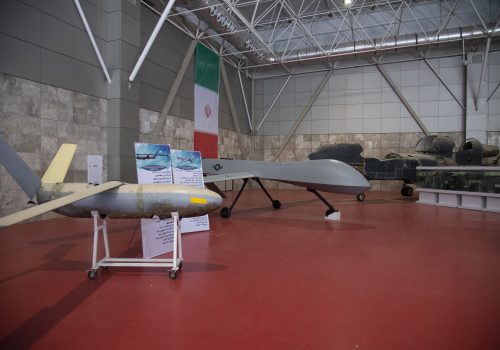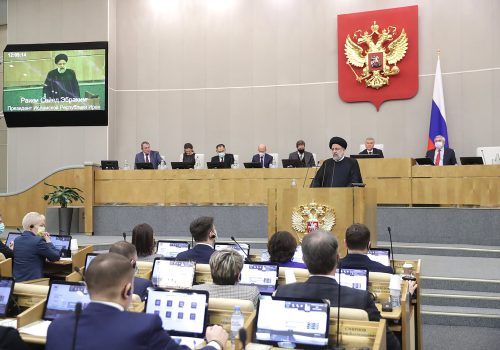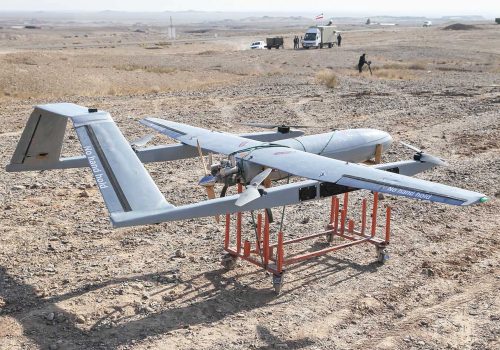Iran’s export of drones to Russia will lead to more proliferation and threaten US partners
Russia’s increasing use of Iranian drones in the war in Ukraine has spotlighted the danger that Iran’s drones pose globally and regionally. The outcome may be an expanded Iranian drone program, increased proliferation of the drones, and knowledge sharing between Moscow and Tehran that adversely affects Western partners in and outside the Middle East.
Moscow’s acquisition of Iranian military technology, specifically unmanned aerial vehicles (UAVs), represents a new chapter in Iran-Russia relations. It reverses several decades in which Iran sought technology transfers from Russia and other more advanced military powers.
Since Russia invaded Ukraine in February, it has relied on various stand-off weapons. This appears to be linked to Moscow’s desire not to risk using its air force over Ukraine, and a preference for cheaper munitions, such as artillery, to decimate portions of Ukraine. UAVs, or drones, present a way for Moscow to exploit a niche in military technology. Russia began looking into acquiring Iranian drones starting in June, according to US assessments. Whereas drones were once primarily used for surveillance or targeted air strikes, usually by Western countries, now Iran has become a drone warfare pioneer.
For Russia, Iran’s drones represent affordable off-the-shelf weapons it can expend in Ukraine. Iran, meanwhile, gains by finding a new market for its systems and seeing them being used in large numbers. No other country has used Iran’s drones in such quantity. Nevertheless there is still debate within Iran about the efficacy of the exports to Russia.
Iran’s drones fill a unique niche for Russia in the realm of kamikaze drones or what are also called loitering munitions. These weapons are launched from a canister or rack that can be mounted on a truck, with the drone having a warhead encased within its body. Unlike more expensive drones, such as the US Reaper, the Iranian Shahed 136 is built for a one-way mission. The drone is slightly larger than a person and looks like a flying delta-wing. These Iranian drones may have a person controlling them, but often they fly via a pre-programmed route of waypoints and then slam into a target.
Iran makes other types of drones that may also be exported to Russia. These include the Shahed 129, which is designed to look like a US Predator drone, and the Shahed 191, which looks like a delta-wing, similar to a US Sentinel spy drone. It’s not clear if either of these would meet Russia’s needs or if Russia will opt for other types of kamikaze-style drones. Ukraine had said earlier this year that Iran has transferred 2,400 drones to Russia, but it is difficult to estimate the total number transferred by the end of the year. Iran has maintained it sent the drones before the war began.
Iran has used drones since the 1980s, partly to compensate for a lack of new warplanes after the fall of Mohammad Reza Shah Pahlavi’s regime and during its eight-year war with Iraq. Iran’s cities were targeted by Iraq during that conflict and drones became a way for Iran to confront Iraq and later to project power around the region. Over the years, Tehran built families of drones, increasing their range and adding munitions. Much has been written on aspects of Iran’s drone program as it proliferated over the years.
Why kamikaze drones meet Russia’s needs
While Iran has tried to reverse engineer downed American drones, its real success has been using loitering munitions flown on one-way kamikaze missions, like a cruise missile. Similar types of drones and cruise missiles were used in the attack on Saudi Arabia’s Abqaiq facility in 2019, which have been attributed to Iran or Iran-backed militias. Iranian-style drones have also been used in Yemen by Houthi rebels since 2015. With ranges of more than 1,000 km and a warhead of several dozen pounds, the Shahed-136—the type used in Ukraine by Russia—can wreak havoc on infrastructure and civilians. Ukrainian President Volodymyr Zelensky has accused Iran of training “Russian terrorists” to use the drones.
As a customer for Iran, Russia matters more than militias because it’s a nation state and a major power.
Tehran has also exported drones to militias. It moved drones to Iraq during the war on the Islamic State of Iraq and al-Sham (ISIS), increasing the capabilities of Popular Mobilizations Forces (PMFs). Beginning in at least 2016, they were used over the Persian Gulf to harass US naval ships. Later, in 2018, Iran targeted Israel with drones flown from Syria, Iraq, and later from Iran itself, and exported drone technology to the Gaza Strip. This illustrates the expanding circle of Iran’s drone capabilities. Drones were also used by proxies in Lebanon and separately in Iraq and Syria, where they have threatened US forces operating against ISIS. In July 2021, Iranian drones were also involved in an attack on a commercial ship, killing two people in the Gulf of Oman. Additionally, Iran inaugurated a drone factory in Tajikistan over the last year. Each of these extensions represents a new level of success or capability.
Drones were once a Middle East-centric issue, with Israel, the US, and several Gulf states already working to counter the growing drone threat. Now Iran’s drone exports to Russia have led to concerns in the West. To some extent, drones have superseded Iran’s advancing nuclear program as a concern for Western partners.
Implications of Iranian drones in Russian hands
There are several possible outcomes for Iran’s drone exports to Russia. One is that Iran’s drones won’t win the war in Ukraine, thereby illustrating their limitations over time. Ukrainian air defenses are already shooting down the drones in large numbers. Iran will likely study how Western air defense responds to the drones and try to recalibrate them based on their failure rate. Attrition of the drones may encourage Russia and Iran to work more closely. For instance, a video purporting to show a future scenario in which a swarm of Shahed 136 drones attacked the Shaybah energy facility in Saudi Arabia was published in early November. This shows how Iran’s experience in Ukraine might boomerang back to the Middle East.
Iran’s drones could also be a threat to European countries, especially if any conflict grows beyond Ukraine. The major implication for European countries today is that they get to see how the weapon systems they supply to Ukraine measure up against drones. Germany and other European states have already been able to get a look at how anti-aircraft systems are performing and they will learn more over the coming months and be able to analyze successes and failures.
In the meantime, the Iran-Russia drone alliance will provide much-needed cash or cash-in-kind infusions for Iran, which remains under heavy US sanctions. Additionally, Iran-Russia knowledge sharing on technology may improve the Shahed 136 or similar drones that Iran may export. Similarly, expertise gained in Ukraine poses a threat to the US, Israel, the Gulf, and other partner forces in the Middle East. In a like manner, Iran is increasingly standardizing the assembly of drones, streamlining them to become more lethal and efficient. Finally, Iran is likely to find more markets for its drones among nation states, with possible links to China for procurement of drone components.
Iran’s supply of drones to Russia has been one of the major surprises of Moscow’s war on Ukraine. The use of a new type of unmanned technology, which is employed in a unique way by Moscow, has broad implications for Iran’s drone program and the way the drone threat may be perceived in the Middle East and Europe.
Seth J. Frantzman is the author of Drone Wars: Pioneers, Killing Machines, Artificial Intelligence and the Battle for the Future. He has a PhD from the Hebrew University of Jerusalem and is a journalist and researcher covering Middle East security issues and defense topics.
Further reading
Thu, Nov 18, 2021
Iran’s drones are clones. Now they’re being used in multiple conflicts.
IranSource By
Iran’s military drone program has grown in recent years and Iran-backed groups have increasingly used drones in conflicts.
Mon, Mar 7, 2022
As the world shuns Russia over its invasion of Ukraine, Iran strengthens its ties with Moscow
IranSource By
Iran’s support for Russian actions reflects the improvement in bilateral ties, which have grown considerably at the political and military levels over the past decade.
Thu, Jun 2, 2022
How Russia’s invasion of Ukraine is shaping national security debates in Iran
IranSource By Sina Azodi
With the future of talks in limbo, the Ukraine war has brought the debates over the future of Iran’s national security strategy to the fore once again.
Image: An Iranian who lives in Ukraine, holds a placard with the inscription 'Iranian military drone go f--- yourself' during a protest against Iran's government and deliveries of Iranian drones to Russia in central Kyiv. Ukrainian authorities said some 400 drones made in Iran were used by Russia in more than 30 drone attacks on Ukraine. Iran has denied supplying weapons to Russia for use in Ukraine. (Photo by Oleksii Chumachenko / SOPA Images/Sipa USA)


